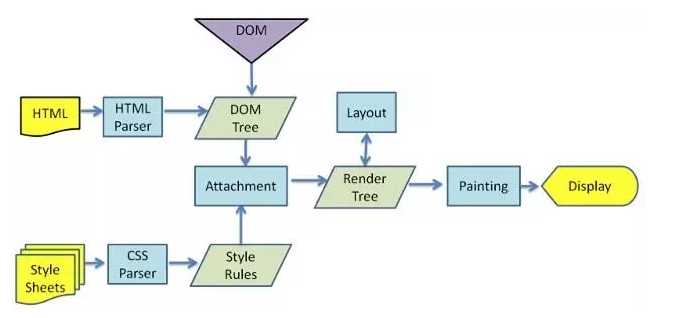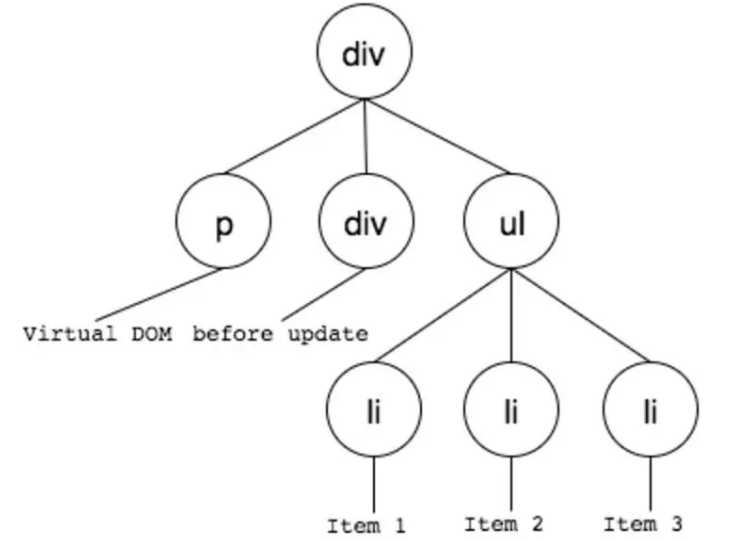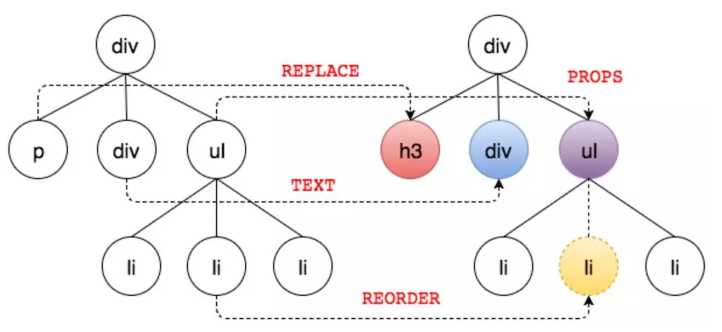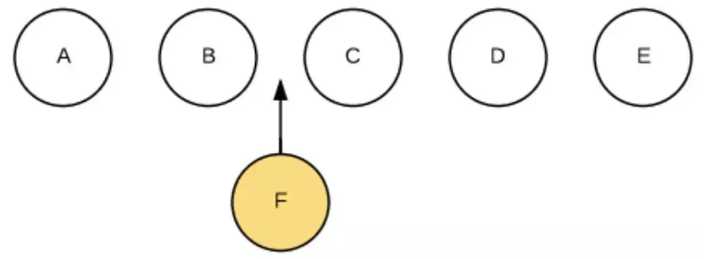标签:eve css 原理 efault ase tst api 理解 写代码
【转自】:https://www.jianshu.com/p/616999666920
先介绍浏览器加载一个HTML文件需要做哪些事,帮助我们理解为什么我们需要虚拟DOM。webkit引擎的处理流程,一图胜千言:

所有浏览器的引擎工作流程都差不多,如上图大致分5步:创建DOM tree –> 创建Style Rules -> 构建Render tree -> 布局Layout –> 绘制Painting
第一步,用HTML分析器,分析HTML元素,构建一颗DOM树。
第二步:用CSS分析器,分析CSS文件和元素上的inline样式,生成页面的样式表。
第三步:将上面的DOM树和样式表,关联起来,构建一颗Render树。这一过程又称为Attachment。每个DOM节点都有attach方法,接受样式信息,返回一个render对象(又名renderer)。这些render对象最终会被构建成一颗Render树。
第四步:有了Render树后,浏览器开始布局,会为每个Render树上的节点确定一个在显示屏上出现的精确坐标值。
第五步:Render数有了,节点显示的位置坐标也有了,最后就是调用每个节点的paint方法,让它们显示出来。
当你用传统的源生api或jQuery去操作DOM时,浏览器会从构建DOM树开始从头到尾执行一遍流程。比如当你在一次操作时,需要更新10个DOM节点,理想状态是一次性构建完DOM树,再执行后续操作。但浏览器没这么智能,收到第一个更新DOM请求后,并不知道后续还有9次更新操作,因此会马上执行流程,最终执行10次流程。显然例如计算DOM节点的坐标值等都是白白浪费性能,可能这次计算完,紧接着的下一个DOM更新请求,这个节点的坐标值就变了,前面的一次计算是无用功。
即使计算机硬件一直在更新迭代,操作DOM的代价仍旧是昂贵的,频繁操作还是会出现页面卡顿,影响用户的体验。真实的DOM节点,哪怕一个最简单的div也包含着很多属性,可以打印出来直观感受一下:

我们来实现一个虚拟DOM。例如一个真实的DOM节点:代码见仓库里的src/firstStep
<div id="real-container"> <p>Real DOM</p> <div>cannot update</div> <ul> <li className="item">Item 1</li> <li className="item">Item 2</li> <li className="item">Item 3</li> </ul> </div>
用js对象来模拟DOM节点如下:
const tree = Element(‘div‘, { id: ‘virtual-container‘ }, [
Element(‘p‘, {}, [‘Virtual DOM‘]),
Element(‘div‘, {}, [‘before update‘]),
Element(‘ul‘, {}, [
Element(‘li‘, { class: ‘item‘ }, [‘Item 1‘]),
Element(‘li‘, { class: ‘item‘ }, [‘Item 2‘]),
Element(‘li‘, { class: ‘item‘ }, [‘Item 3‘]),
]),
]);
const root = tree.render();
document.getElementById(‘virtualDom‘).appendChild(root);
用js对象模拟DOM节点的好处是,页面的更新可以先全部反映在js对象上,操作内存中的js对象的速度显然要快多了。等更新完后,再将最终的js对象映射成真实的DOM,交由浏览器去绘制。
那具体怎么实现呢?看一下Element方法的具体实现:
function Element(tagName, props, children) { if (!(this instanceof Element)) { return new Element(tagName, props, children); } this.tagName = tagName; this.props = props || {}; this.children = children || []; this.key = props ? props.key : undefined; let count = 0; this.children.forEach((child) => { if (child instanceof Element) { count += child.count; } count++; }); this.count = count; }
第一个参数是节点名(如div),第二个参数是节点的属性(如class),第三个参数是子节点(如ul的li)。除了这三个参数会被保存在对象上外,还保存了key和count。

有了js对象后,最终还需要将其映射成真实的DOM:
Element.prototype.render = function() { const el = document.createElement(this.tagName); const props = this.props; for (const propName in props) { setAttr(el, propName, props[propName]); } this.children.forEach((child) => { const childEl = (child instanceof Element) ? child.render() : document.createTextNode(child); el.appendChild(childEl); }); return el; };
上面都是自解释代码,根据DOM名调用源生的createElement创建真实DOM,将DOM的属性全都加到这个DOM元素上,如果有子元素继续递归调用创建子元素,并appendChild挂到该DOM元素上。这样就完成了从创建虚拟DOM到将其映射成真实DOM的全部工作。
我们已经完成了创建虚拟DOM并将其映射成真实DOM的工作,这样所有的更新都可以先反映到虚拟DOM上,如何反映呢?需要明确一下Diff算法。
两棵树如果完全比较时间复杂度是O(n^3),但参照《深入浅出React和Redux》一书中的介绍,React的Diff算法的时间复杂度是O(n)。要实现这么低的时间复杂度,意味着只能平层地比较两棵树的节点,放弃了深度遍历。这样做,似乎牺牲了一定的精确性来换取速度,但考虑到现实中前端页面通常也不会跨层级移动DOM元素,所以这样做是最优的。
const newTree = Element(‘div‘, { id: ‘virtual-container‘ }, [
Element(‘h3‘, {}, [‘Virtual DOM‘]), // REPLACE
Element(‘div‘, {}, [‘after update‘]), // TEXT
Element(‘ul‘, { class: ‘marginLeft10‘ }, [ // PROPS
Element(‘li‘, { class: ‘item‘ }, [‘Item 1‘]),
// Element(‘li‘, { class: ‘item‘ }, [‘Item 2‘]), // REORDER remove
Element(‘li‘, { class: ‘item‘ }, [‘Item 3‘]),
]),
]);
只考虑平层地Diff的话,就简单多了,只需要考虑以下4种情况:
第一种是最简单的,节点类型变了,例如下图中的P变成了h3。我们将这个过程称之为REPLACE。直接将旧节点卸载(componentWillUnmount)并装载新节点(componentWillMount)就行了。

(为简单起见上图隐藏了文本节点)
旧节点包括下面的子节点都将被卸载,如果新节点和旧节点仅仅是类型不同,但下面的所有子节点都一样时,这样做显得效率不高。但为了避免O(n^3)的时间复杂度,这样做是值得的。这也提醒了React开发者,应该避免无谓的节点类型的变化,例如运行时将div变成p就没什么太大意义。
第二种也比较简单,节点类型一样,仅仅属性或属性值变了。
renderA: <ul>
renderB: <ul class: ‘marginLeft10‘>
=> [addAttribute class "marginLeft10"]
我们将这个过程称之为PROPS。此时不会触发节点的卸载(componentWillUnmount)和装载(componentWillMount)动作。而是执行节点更新(shouldComponentUpdate到componentDidUpdate的一系列方法)。
function diffProps(oldNode, newNode) { const oldProps = oldNode.props; const newProps = newNode.props; let key; const propsPatches = {}; let isSame = true; // find out different props for (key in oldProps) { if (newProps[key] !== oldProps[key]) { isSame = false; propsPatches[key] = newProps[key]; } } // find out new props for (key in newProps) { if (!oldProps.hasOwnProperty(key)) { isSame = false; propsPatches[key] = newProps[key]; } } return isSame ? null : propsPatches; }
第三种是文本变了,文本对也是一个Text Node,也比较简单,直接修改文字内容就行了,我们将这个过程称之为TEXT。
第四种是移动,增加,删除子节点,我们将这个过程称之为REORDER。具体可以看这篇虚拟DOM Diff算法解析。例如:

在中间插入一个节点,程序员写代码很简单:$(B).after(F)。但如何高效地插入呢?简单粗暴的做法是:卸载C,装载F,卸载D,装载C,卸载E,装载D,装载E。如下图:


如果我们在JSX里为数组或枚举型元素增加上key后,React就能根据key,直接找到具体的位置进行操作,效率比较高。如下图:

{ 1: [ {type: REPLACE, node: Element} ], 4: [ {type: TEXT, content: "after update"} ], 5: [ {type: PROPS, props: {class: "marginLeft10"}}, {type: REORDER, moves: [{index: 2, type: 0}]} ], 6: [ {type: REORDER, moves: [{index: 2, type: 0}]} ], 8: [ {type: REORDER, moves: [{index: 2, type: 0}]} ], 9: [ {type: TEXT, content: "Item 3"} ], }
虚拟DOM有了,Diff也有了,现在就可以将Diff应用到真实DOM上了。代码见仓库里的src/thirdStep
深度遍历DOM将Diff的内容更新进去:
function dfsWalk(node, walker, patches) { const currentPatches = patches[walker.index]; const len = node.childNodes ? node.childNodes.length : 0; for (let i = 0; i < len; i++) { walker.index++; dfsWalk(node.childNodes[i], walker, patches); } if (currentPatches) { applyPatches(node, currentPatches); } }
具体更新的代码如下,其实就是根据Diff信息调用源生API操作DOM:
function applyPatches(node, currentPatches) { currentPatches.forEach((currentPatch) => { switch (currentPatch.type) { case REPLACE: { const newNode = (typeof currentPatch.node === ‘string‘) ? document.createTextNode(currentPatch.node) : currentPatch.node.render(); node.parentNode.replaceChild(newNode, node); break; } case REORDER: reorderChildren(node, currentPatch.moves); break; case PROPS: setProps(node, currentPatch.props); break; case TEXT: if (node.textContent) { node.textContent = currentPatch.content; } else { // ie node.nodeValue = currentPatch.content; } break; default: throw new Error(`Unknown patch type ${currentPatch.type}`); } }); }
虚拟DOM的目的是将所有操作累加起来,统计计算出所有的变化后,统一更新一次DOM。其实即使不懂原理,业务代码照样写,但理解原理后,出了什么新东东如React Fiber才能快速跟上。前端就是这样痛并快乐着。
标签:eve css 原理 efault ase tst api 理解 写代码
原文地址:https://www.cnblogs.com/fengyuexuan/p/11083419.html